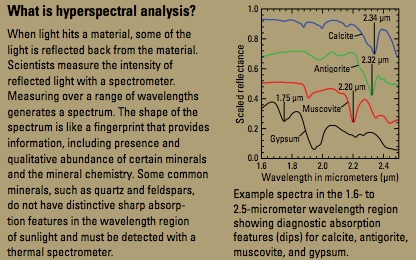Researchers do hyperspectral surveys to search for copper in Alaska
The U.S. Geological Survey is using a familiar exploration technology to search for copper deposits in remote locations of Alaska.
Starting in 2014, researchers with USGS began studying the remote eastern Alaskan Range where copper porphyry deposits are known to exist, using hyperspectral surveying. The technique employs aircraft equipped with instruments that emit light. When the light hits a material, some of the light is reflected back, allowing scientists to measure it with a spectrometer. The shape of the spectrum is like a fingerprint that reveals the chemical composition of the rocks.
"We wanted to push the application of the technology in jagged terrain that poses challenges for aiming and aligning sensors and other equipment," Raymond Kokaly, a research geophysicist at the U.S. Geological Survey (USGS) Crustal Geophysics and Geochemistry Science Center in Denver, CO, and lead author on the study, told EOS, a site published by the American Geophysical Union that covers earth and space science news.


Screenshot capture of USGS Fact Sheet.


In Alaska the geophysicists were specifically searching for the mineral muscovite, which is known to be associated with copper porphyries.
"In collaboration with the Alaska Division of Geological and Geophysical Surveys, the University of Alaska Fairbanks, and the National Park Service, the USGS is collecting and analyzing hyperspectral data with the goals of enhancing geologic mapping and developing methods to identify and characterize mineral deposits elsewhere in Alaska," reads a fact sheet of the program written by the team.
After two days of flying over the area, a total of 1,900 square kilometres, the team mapped locations where muscovite was present in various quantities. The locations were then compared to known copper deposits, looking for patterns in the wavelengths of light that had been reflected back to the instruments. They found the densest muscovite deposits correlated with the known porphyries.
Kokaly told EOS that if the technique proves reliable, they may use hyperspectral imaging to explore for other minerals including gold and silver.